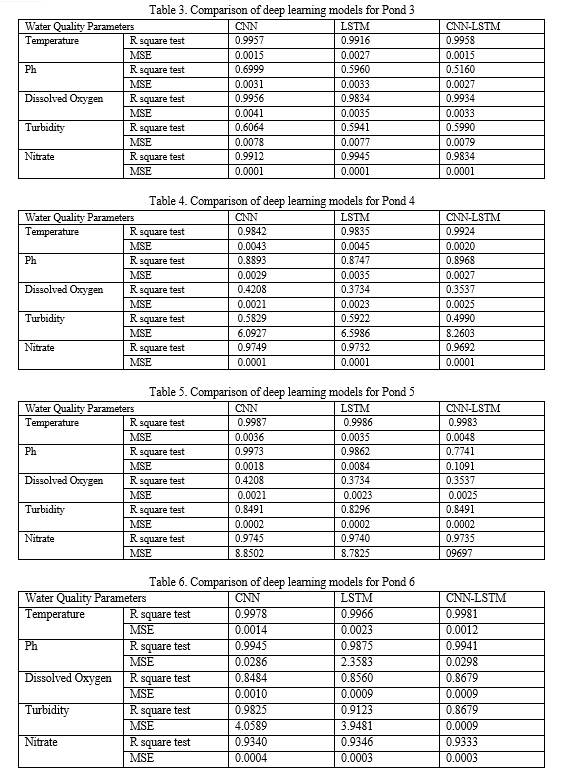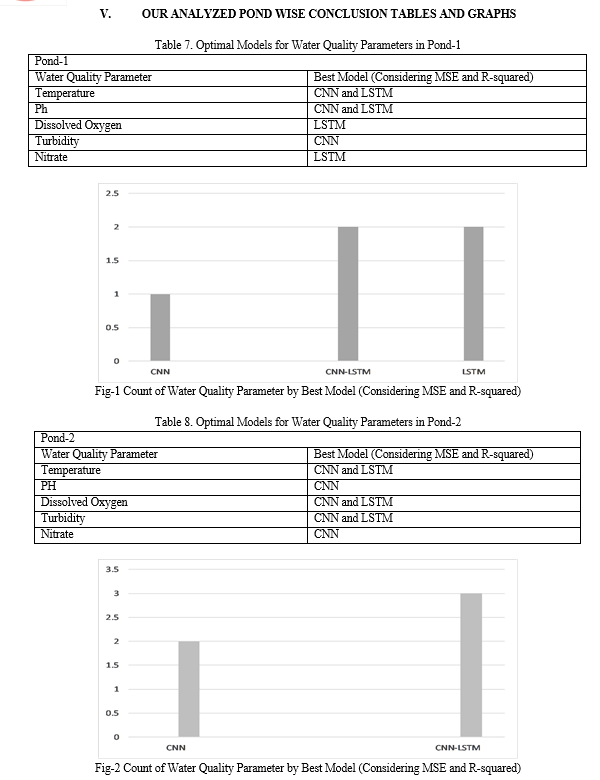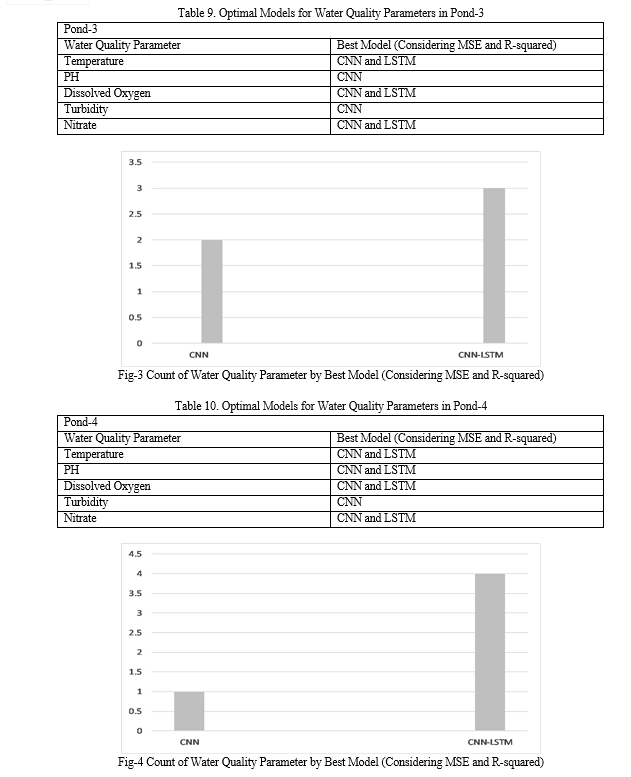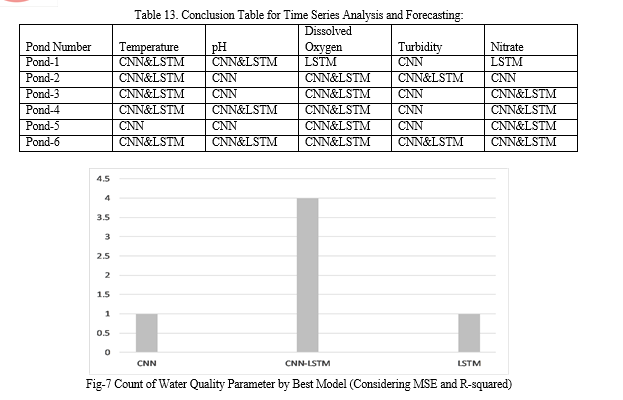Ijraset Journal For Research in Applied Science and Engineering Technology
- Home / Ijraset
- On This Page
- Abstract
- Introduction
- Conclusion
- References
- Copyright
Real Time Water Quality Based Predictive Alert System for Aquaculture
Authors: Aryan Sri Venkat Devanaboina, Naveen Chakravarthi Dachepalli, Sirisha Gorla, Praveen Kama, Vyshnavi Gubbala
DOI Link: https://doi.org/10.22214/ijraset.2024.59211
Certificate: View Certificate
Abstract
Aquaculture plays a crucial role in addressing the growing worldwide need for seafood. Nevertheless, maintaining ideal water conditions is vital for the well-being and efficiency of aquatic organisms. This initiative presents a holistic remedy for aquaculture activities: the creation of a real time water quality based predictive alert system. This system places specific emphasis on monitoring five crucial parameters: temperature, pH, and dissolved oxygen (DO), Nitrate, Turbidity. It utilizes strategically positioned sensors to provide real-time data. Through advanced analysis and deep learning models, it predicts potential issues, send alerts to the aquatic manager enabling them to proactively optimize conditions, improve aquatic health, and minimize economic losses.
Introduction
I. INTRODUCTION
Aquaculture, as a cornerstone of global food security, continually seeks innovative solutions to enhance productivity, sustainability, and the overall health of aquatic ecosystems [1]. Our project, titled "Real-Time Water Quality Monitoring and Time Series-Based Predictive Alert System for Aquaculture," integrates three crucial components to address the dynamic challenges faced by the aquaculture industry [2]. These components include:
A. Real time Water Quality Monitoring
At the core of our project is the incorporation of state-of-the-art sensor technologies to enable real-time monitoring of water quality. Traditional monitoring methods often fall short in providing timely insights into the complex dynamics of aquatic environments. Through the deployment of advanced sensors, we aim to capture and analyze key parameters such as pH, dissolved oxygen, temperature, turbidity and nutrient levels in real-time. This continuous monitoring allows for a proactive approach to maintaining optimal water conditions, mitigating the risk of adverse effects on aquatic organisms [3].
B. Time Series Analysis & Prediction
Complementing real-time monitoring, our project incorporates time series prediction models to anticipate changes in water quality parameters over time. Leveraging historical data and patterns, these predictive models enable us to forecast potential variations in the aquatic environment. By understanding the trends and fluctuations in water quality, aqua farmers can make informed decisions to prevent imbalances, reduce the likelihood of disease outbreaks, and optimize the overall conditions for the thriving of aquatic species [4].
C. Predictive Alert System
The predictive capabilities of our time series models seamlessly integrate with an advanced alert system. This system acts as a pre-emptive measure, providing aqua farmers with timely notifications and alerts when the predicted changes in water quality parameters surpass predefined thresholds [5].
Such alerts empower aqua farmers to take swift corrective actions, ensuring the well-being of the aquatic population and preventing economic losses. The alert system serves as a proactive tool to maintain a stable and conducive environment for aquaculture operations [6].
In summary, our comprehensive approach brings together real-time water quality monitoring, time series prediction, and an alert system, forming an integrated solution that not only identifies current conditions but also anticipates future changes. By synergizing these three components, our project aims to revolutionize aquaculture practices, fostering a sustainable and resilient industry capable of meeting the growing demand for seafood in a rapidly changing global landscape.
II. LITERATURE SURVEY
- Most existing systems rely on manual water quality testing or basic real-time monitoring. There is a need for an automated system for continuous and predictive monitoring.
- Current systems are limited in predicting future trends and anomalies in water quality. Advanced analytics using time series forecasting can enable predictive alerts.
- Many systems do not provide a holistic monitoring solution covering all critical parameters like pH, DO, ammonia, temperature, etc. There is scope for a comprehensive system.
- Remote monitoring capabilities of existing solutions are limited. A system with cloud connectivity and mobile apps can enable access from anywhere.
- Machine learning has not been fully explored for anomaly detection and predictive analytics in aquaculture monitoring. There is potential to leverage ML for predictive alerts.

III. METHODOLOGY
A. Real-Time Water Quality Monitoring
In the domain of aquaculture, the forefront in safeguarding the well-being and productivity of aquatic environments is represented by the real-time monitoring of water quality. Our project employs the sophisticated hardware components to create a robust monitoring system.
- Hardware Components
To capture the intricate nuances of aquatic conditions, our system is equipped with a variety of state-of-the-art sensors:
a. Temperature Sensor: Monitors the water temperature, a crucial parameter influencing the metabolic rates of aquatic organisms.
b. pH Sensor: Measures the acidity or alkalinity of the water, providing insights into the chemical balance essential for aquatic life.
c. Dissolved Oxygen Sensor: Ensures real-time tracking of oxygen levels in water, vital for the respiration of aquatic species.
d. Nitrate Sensor: Monitors nitrate levels, a key indicator of nutrient balance and potential pollution in aquaculture systems.
e. Turbidity Sensor: Gauges water clarity by measuring suspended particles, offering insights into the overall water quality and the effectiveness of filtration systems. Together, these sensors constitute the essential hardware infrastructure, seamlessly blending into the aquaculture surroundings to offer a thorough comprehension of crucial water quality parameters.
f. Microcontroller: Microcontrollers can interface with various sensors, including pH, temperature, dissolved oxygen, turbidity, and nitrate sensors. By continuously monitoring these parameters in real-time, the microcontroller helps aqua farmers maintain optimal water conditions for the health and growth of aquatic organisms.
B. Time Series Analysis and Prediction
Building upon the wealth of data collected by our advanced sensor array, our project incorporates cutting-edge time series prediction models to forecast changes in water quality parameters. The goal is to leverage the historical data to anticipate trends and variations, enabling aqua farmers to take proactive measures for maintaining optimal conditions. This procedure employs three distinct deep learning models: Convolutional Neural Network, Long Short-Term Memory, and a combined CNN and LSTM model [7].
- Data Preprocessing
The journey begins with preprocessing the data collected by the sensors. This involves cleaning, normalizing, and organizing the data to create a coherent dataset suitable for training and validating our predictive models.
2. Applying Deep Learning Models
a. CNN -Convolutional Neural Network: Although CNNs have conventionally been used in image processing, their effectiveness also applies to sequential data, proving advantageous for time series forecasting. In our aquaculture initiative, the CNN is customized to detect spatial patterns present in the temporal sequences of water quality parameters. The structure comprises convolutional layers that utilize filters across consecutive data points, capturing characteristics that signify local patterns and fluctuations. This ability to discern spatial relationships in the time series data is particularly relevant for understanding fluctuations in temperature, pH, dissolved oxygen, Turbidity and Nitrate levels. Each convolutional layer captures increasingly complex patterns, contributing to a holistic representation of the temporal dynamics. The convolutional layers produce results that are flattened and inputted into densely connected layers, enabling the network to acquire higher-level abstractions. The CNN's capability to autonomously extract pertinent features from the time series enhances its efficacy in predicting the dynamic variations of aquaculture water quality parameters.
b. LSTM -Long Short-Term Memory: LSTM networks overcome the shortcomings of conventional recurrent neural networks (RNNs) by effectively capturing extended dependencies in sequential data. In our aquaculture system, LSTMs are instrumental in understanding the temporal dynamics of water quality parameters. The LSTM design incorporates memory cells and gates to regulate information flow, enabling the preservation of context for prolonged time durations [8]. For each parameter, the LSTM network learns to capture the sequential dependencies, recognizing patterns and trends that may span significant time intervals. This is crucial for accurately forecasting the changes in Temperature, pH, dissolved oxygen, turbidity, Nitrate levels, which may exhibit intricate patterns over time. The LSTM's ability to selectively retain and discard information from the past, coupled with its resistance to the vanishing gradient problem, makes it well-suited for modeling the complex temporal dynamics inherent in aquaculture water quality data [9].
c. CNN and LSTM Hybrid Model: The hybrid model of cnn-lstm represents a synergistic approach to time series forecasting, combining the spatial pattern recognition of CNNs with the temporal dependency modeling of LSTMs [10] This hybrid architecture is particularly potent for understanding the complex interactions within aquaculture water quality data. The model begins with convolutional layers that act as feature extractors, identifying spatial patterns within the time series. The CNN layers generate output, which is subsequently fed into LSTM layers, enabling the model to capture extended relationships rooted in spatial features. This collaborative process enables the hybrid model to leverage both local and global contextual information, enhancing its ability to make accurate predictions [11][12]. By combining the strengths of CNNs and LSTMs, the hybrid model offers a holistic understanding of the temporal and spatial aspects of water quality parameters. Through our comparative analysis, we aim to showcase the effectiveness of the CNN & LSTM hybrid model in providing accurate and reliable forecasts for aquaculture systems [13]. We took a dataset consisting of water quality data from 6 ponds, applied deep learning models to the dataset, and noted the report. Consistently displaying superior performance, CNN - LSTM outshines other models consistently in various ponds, showcasing its robust ability to capture both spatial and temporal patterns in water quality data. The widespread preference for CNN -LSTM highlights its efficacy as a dependable model for predicting diverse water quality parameters in different pond settings.
3. Integration with Real-Time Monitoring
Once the optimal model is determined, it is seamlessly integrated into the real-time monitoring system. This ensures that the predictive capabilities continually evolve and adapt to changing conditions, providing aqua farmers with timely insights and enabling them to stay one step ahead in maintaining a healthy aquatic environment.
In the subsequent sections, we will explore how the predictive capabilities of our models integrate with the alert system, creating a holistic solution for proactive aquaculture management.
C. Predictive Alert System
The heart of our project lies in the implementation of a robust Predictive Alert System, designed to proactively notify aqua farmers of impending changes in water quality parameters. This advanced system seamlessly integrates with the time series prediction models, ensuring aqua farmers are equipped with timely information to take preventive measures.
- Threshold Based Alerts: The Predictive Alert System employs predetermined thresholds for crucial water quality parameters, including temperature, pH, dissolved oxygen, nitrate, and turbidity.[14] When the time series prediction models indicate potential deviations beyond these thresholds, the alert system triggers immediate notifications.
- SMS Notifications: Employing Short Message Service (SMS) technology, the alert system sends instant notifications directly to aqua farmers. This direct and immediate communication ensures that farmers receive critical information in real-time, allowing for swift and informed decision-making.
- Customizable Alerts: Recognizing the diverse needs of aqua farmers, our system offers customizable alert preferences. Farmers can tailor the system to prioritize specific parameters or set different response levels based on the severity of predicted deviations.
By integrating this Predictive Alert System into aquaculture operations, we aim to transform the reactive nature of responding to water quality issues into a proactive and preventative approach. This not only ensures the well-being of aquatic organisms but also enhances the overall efficiency and sustainability of aquaculture practices.[15] In the subsequent Predictive Alert System in real-world aquaculture scenarios we will delve into the practical implications and outcomes of deploying this.






VI. ACKNOWLEDGMENT
We wish to express our sincere appreciation to the authors whose contributions have laid the groundwork for our investigation in real-time water quality monitoring and time series-based predictive alert systems for aquaculture. Their expertise and dedication in the fields of deep learning and aquaculture have profoundly influenced our work. The insightful writings of these authors have played a crucial role in shaping and validating our solution.
Conclusion
In conclusion, we have effectively created a real-time system for monitoring water quality, gathering data from strategically positioned sensors. storing it in the cloud. The dataset was subjected to analysis using deep learning models, including CNN, LSTM, and hybrid CNN&LSTM. Through rigorous evaluation, the CNN&LSTM model emerged as the most effective for the dataset. Subsequently, this model was employed for time series forecasting. The project further incorporated an alert system, ensuring that predicted values remain within specified threshold values for parameters. In the event of any parameter exceeding the set thresholds, alerts are promptly sent to the aquafarmer. This integrated approach not only optimizes aquaculture conditions but also facilitates proactive management, thereby contributing to improved aquatic health and minimized economic losses.
References
[1] Lu, J.; Lin, Y.C.; Wu, J.; Zhang, C. Continental-scale spatial distribution, sources, and health risks of heavy metals in seafood: Challenge for the water-food-energy nexus sustainability in coastal regions? Environ. Sci. Pollut. Res. 2021, 28, 1–14. [2] Tang, Q., Wu, D., & Zhang, W. (2015). Real-time water quality monitoring system design for aquaculture. In 2015 IEEE International Conference on Information and Automation (ICIA) (pp. 2496-2501). [DOI: 10.1109/ICInfA.2015.7279607] [3] Sharma, D., & Kumar, R. (2021). Smart aquaculture: integration of sensors, biosensors, and artificial intelligence. Biosensors in Agriculture: Recent Trends and Future Perspectives, 455-464. [4] Shamsudin, M. N., & Alias, N. E. (2019). A review on decision support systems in aquaculture. Aquaculture, 499, 47-55. [DOI:10.1016/j.aquaculture.2018.08.013] [5] Zhang, Y., Wu, Y., & Zhou, C. (2018). A real-time prediction and monitoring system for water quality in rivers based on hybrid models. Journal of Cleaner Production, 196, 924-933. [DOI: 10.1016/j.jclepro.2018.06.070] [6] Boyd, C. E. (2015). Water quality in ponds for aquaculture. Alabama Agricultural Experiment Station. [ISBN: 978-0-8173-8765-8] [7] Y. Liang, S. Ke, J. Zhang, X. Yi, and Y. Zheng, ``GeoMAN: Multi-level attention networks for geo-sensory time series prediction,\'\' in Proc. 27th Int. Joint Conf. Artif. Intell., Jul. 2018, pp. 3428_3434. [8] Hochreiter, S., & Schmidhuber, J. (1997). Long short-term memory. Neural Computation, 9(8), 1735-1780. [DOI: 0.1162/neco.1997.9.8.1735] [9] Greff, K., Srivastava, R. K., Koutnik, J., Steunebrink, B. R., & Schmidhuber, J. (2015). LSTM: A search space odyssey. IEEE Transactions on Neural Networks and Learning Systems, 28(10), 2222-2232. [DOI: 10.1109/TNNLS.2016.2582924] [10] Karim, F., Majumdar, S., & Darabi, H. (2018). LSTM-CNN Model for Offline Handwriting Recognition. In 2018 16th International Conference on Frontiers in Handwriting Recognition (ICFHR) (pp. 63-68). [DOI: 10.1109/ICFHR-2018.2018.00019] [11] Shi, X., Chen, Z., Wang, H., Yeung, D. Y., Wong, W. K., & Woo, W. C. (2015). Convolutional LSTM Network: A Machine Learning Approach for Precipitation Nowcasting. In Advances in Neural Information Processing Systems (NeurIPS) (pp. 802810).[URL:https://proceedings.neurips.cc/paper/2015/file/07563a3fe3bbe7e3ba84431ad9d055af-Paper.pdf] [12] Zhang, Z., Cui, P., & Zhu, W. (2018). Deep learning on graphs: A survey. IEEE Transactions on Knowledge and Data Engineering, 31(12), 2321-2343. [DOI: 10.1109/TKDE.2018.2851672] [13] Chen, D., Jiang, H., Li, Q., & Yang, Y. (2019). A hybrid deep learning model for water quality prediction in rivers. Environmental Monitoring and Assessment, 191(2), 87. [DOI: 10.1007/s10661-019-7204-y] [14] Ruan, X., Shu, L., Wu, D., & Wang, X. (2016). An Intelligent Transportation System Architecture Based on Cloud Computing and the Internet of Things. IEEE Transactions on Industrial Informatics, 12(4), 1521-1529. [DOI: 10.1109/TII.2016.2592991] [15] Zhang, Y., Liu, F., & Liu, Y. (2017). A review on intelligent sensing and environmental monitoring for aquaculture. Computers and Electronics in Agriculture, 139, 146-156. [DOI: 10.1016/j.compag.2017.05.010]
Copyright
Copyright © 2024 Aryan Sri Venkat Devanaboina, Naveen Chakravarthi Dachepalli, Sirisha Gorla, Praveen Kama, Vyshnavi Gubbala. This is an open access article distributed under the Creative Commons Attribution License, which permits unrestricted use, distribution, and reproduction in any medium, provided the original work is properly cited.

Download Paper
Paper Id : IJRASET59211
Publish Date : 2024-03-20
ISSN : 2321-9653
Publisher Name : IJRASET
DOI Link : Click Here
 Submit Paper Online
Submit Paper Online

